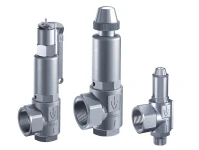- What are cryogenic valves, and how do they differ from standard valves?
- What are the primary applications of cryogenic valves in industrial settings?
- What materials are typically used in the construction of cryogenic valves, and why?
- How are cryogenic valves designed to handle the extremely low temperatures associated with cryogenic hydrogen?
- What safety measures are implemented in cryogenic valves to prevent leaks or malfunctions?
- How do cryogenic valves handle the unique challenges of hydrogen, such as its low density and high reactivity?
- What are the key performance characteristics to evaluate when assessing the quality of a cryogenic valve?
- How does the maintenance and servicing of cryogenic valves differ from standard valves?
- Are there any specific regulations or standards that govern the design and use of cryogenic valves?
Browse all valves, including cryogenic valves from leading suppliers on our marketplace!
What are cryogenic valves, and how do they differ from standard valves?
The types of valves used in cryogenic hydrogen plants are well-known from other processes and include globe valves, ball valves, gate valves as well as safety – and overflow valves.
Cryogenic valves are designed so that they can be used far below ambient temperature. For hydrogen, the lowest temperature is usually around -253°C (20K) where it becomes liquid. This is 59° colder even than liquid nitrogen, which means that there are additional requirements for the design of the materials used in the valves. Many cryogenic valves go all the way down to liquid helium temperature at -269°C (4K).
What are the primary applications of cryogenic valves in industrial settings?
Because hydrogen is a very light gas its density must be increased to handle it. Liquefaction is one of the options that enable the transportation of hydrogen over long distances. Cryogenic valves are used in the liquefaction process and all the subsequent steps in the value chain. This includes applications like liquid hydrogen tanks, transport trailers and ships, export and import terminals, but also applications closer to the end user like liquid hydrogen-fueled trucks and aircraft.
What materials are typically used in the construction of cryogenic valves, and why?
Cryogenic valves are usually made of high-quality austenitic steel to withstand cold temperatures and increase resistance to hydrogen embrittlement. However, resistance to embrittlement can be further improved by ensuring a constant high nickel content in materials used for hydrogen valves. Also, the sealing materials must be selected carefully and are usually variations of PTFE, PCTFE or the same high-quality steels. The following are the most commonly used materials used for the construction of cryogenic valves.
- Stainless Steel (e.g., 316L): Stainless steel is widely used in cryogenic applications due to its good mechanical properties, corrosion resistance, and ability to maintain strength at low temperatures. It can withstand the cryogenic temperatures of hydrogen and offers good durability.
- Inconel: Inconel alloys are known for their high-temperature strength and resistance to corrosion and oxidation. They are often used in cryogenic valves to handle extreme conditions and prevent material degradation. However, Inconel is not very suitable for use with hydrogen as it suffers from hydrogen embrittlement.
- Aluminum and Aluminum Alloys: Aluminum and its alloys are lightweight and possess reasonable strength and corrosion resistance. They can be suitable for specific cryogenic applications where weight reduction is important.
- Brass and Bronze: These materials are often used for valve components that require good machinability and corrosion resistance. They do not suffer from hydrogen embrittlement. However, their use is not common below a liquid nitrogen temperature of -196°C.
- Copper: Copper and its alloys can provide good thermal conductivity and corrosion resistance. They may be used in specific cryogenic valves where these properties are advantageous.
- PTFE (Polytetrafluoroethylene): PTFE and PCTFE are common choices for valve seals and seats due to their excellent low-temperature performance and chemical resistance. It maintains a reliable seal even at cryogenic temperatures.
- Viton and Other Elastomers: Certain elastomers, such as Viton, are designed to retain their flexibility and sealing properties at low temperatures. They are used in valve seals and gaskets to ensure leak-tightness.
- Cryogenic Steels: Some specialized steels are designed specifically for cryogenic applications. These steels are formulated to maintain ductility and toughness at extremely low temperatures. Hydrogen compatibility must be assessed for these steels.
- Cryogenic Alloys: Various alloys are developed for use in cryogenic conditions, combining properties such as low thermal expansion, good strength, and corrosion resistance. These alloys are tailored to maintain their performance in extreme cold. As with cryogenic steels, hydrogen compatibility must be assessed.
- Titanium: Titanium and its alloys offer good strength-to-weight ratio, corrosion resistance, and low thermal conductivity, making them suitable for certain cryogenic valve components. Where pure titanium has relatively good hydrogen resistance, that of titanium alloys can be less so.
- Nylon and other Polymers: Some polymer materials may be used in non-metallic valve components, such as handles or grips. However, their use in cryogenic applications might be limited due to potential brittleness at low temperatures.
How are cryogenic valves designed to handle the extremely low temperatures associated with cryogenic hydrogen?
Apart from selecting suitable materials, the design must consider the contraction of the different materials when the temperature is reduced to these very low values. Like with other cryogenic valves, the hand wheel (or actuator) is placed on an elongated stem to ensure that users do not come into contact with extremely cold parts. For these very low temperatures, it is important that the heat flow from the outside into the hydrogen system is minimized. This requires special designs to reduce conduction through the metal and vacuum insulation of the valves and the piping.
What safety measures are implemented in cryogenic valves to prevent leaks or malfunctions?
The safety measures implemented in cryogenic hydrogen valves to prevent leaks or malfunctions are fundamentally aligned with the factors considered when selecting valves for other substances. These factors encompass material compatibility, temperature range, pressure limit, and the necessary flow rate. However, due to the unique challenges posed by cryogenic hydrogen, specialized design considerations and additional precautions are taken to ensure safe operation.
Valve Design and Material Selection: Cryogenic hydrogen valves are meticulously designed and constructed to withstand extreme cold and potential thermal stresses. Materials are chosen for their ability to maintain structural integrity and sealing properties under cryogenic conditions.
Double Block and Bleed (DBB) Systems: Many cryogenic hydrogen valves incorporate a double block and bleed configuration, which enhances safety by providing dual closure mechanisms and an intervening bleed valve for controlled gas release between closures.
Seat and Seal Materials: The valves are equipped with seat and seal materials optimized for cryogenic temperatures, ensuring reliable and durable sealing performance.
Valve Insulation: Insulation is often applied to cryogenic valves to prevent ice buildup and maintain stable operating temperatures, minimizing the risk of freezing and operational disruptions.
Pressure Rating and Design: Cryogenic hydrogen valves are designed with specific pressure ratings that indicate the maximum pressure they can safely handle. These ratings are determined through engineering calculations, testing, and compliance with industry standards. The valves’ materials, components, and overall construction are chosen to withstand the pressures encountered in cryogenic hydrogen applications.
How do cryogenic valves handle the unique challenges of hydrogen, such as its low density and high reactivity?
The relatively low density of hydrogen and even liquid hydrogen means that larger valves are needed to handle the same mass flow compared to other fluids. We can calculate the size needed for various applications or various sizing software like Valvio can be used to calculate the sizing of valves for required applications. The high reactivity is handled by selecting suitable materials for the valves and making sure that there is nothing in the piping that can react chemically with hydrogen, for example by installing check valves and strainers. This is part of the overall design of the hydrogen process equipment.
What are the key performance characteristics to evaluate when assessing the quality of a cryogenic valve?
Cryogenic valves must fulfil the relevant standards and remain durable and reliable in the field. When assessing the quality of a cryogenic hydrogen valve, several key performance characteristics should be carefully evaluated to ensure safe and reliable operation in handling extremely cold hydrogen gas. These characteristics provide insights into the valve’s suitability for its intended application and its ability to meet operational requirements. Some of these important characteristics are leakage rate, pressure drop, flow capacity, temperature stability, material compatibility, reliability, response time, sealing mechanism, actuation mechanism and environmental impact.
How does the maintenance and servicing of cryogenic valves differ from standard valves?
It is important that no air or other media can enter hydrogen process equipment. This is even more important for cryogenic hydrogen systems, where oxygen and nitrogen would solidify creating unsafe conditions. If you open a hydrogen system for maintenance, you will have to purge with nitrogen and hydrogen before it can be started again. In the case of safety valves this can be preventing by using a changeover valve, which diverts the flow from one to another safety valve. The first safety valve can then be maintained or replaced without stopping the process.
Similarly, top entry valves, like FullX, give access to the inside of the valve without having to break the vacuum of the insulation, making maintenance much cheaper.
Are there any specific regulations or standards that govern the design and use of cryogenic valves?
The design of cryogenic valves falls under the same regulations and standards as other valves, whereby different calculations and material selection criteria apply at extreme temperatures. There are many standards in different stages of readiness for specific applications and areas of the world. These standards include.
- ASME (American Society of Mechanical Engineers) standards
- ISO Standards
- European standards
- National Fire Protection Association (NFPA)
- Compressed gas Association (CGA)
Content contributed by HEROSE GmbH
Last update: 05.09.2023







